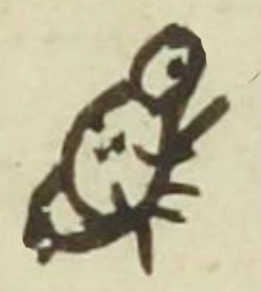Azcatl (MH503v)
This black-line drawing of the simplex glyph for the personal name Azcatl ("Ant," attested here as a man’s name) shows a profile view of an ant (azcatl) that is looking upward and to the right. Visible are the head with an eye, a two-part body, and five legs (one additional leg must be behind the others, or it was inadvertently omitted). The body also has some dots and short lines.
Stephanie Wood
The name Azcatl could also be held by Nahua women. A somewhat famous Azcatl Xochitzin was the wife of a ruler of Malinalco, according to Chimalpahin. Another famous Toltec woman name Azcaxochitl married a Chichimec chief called Nopaltzin, according to Rémi Siméon.
Notice the detail and color given the ant glyph in the Codex Mendoza, below. One can imagine a baby being given the name of "ant," given the ant's diminutive size. In English, babies are sometimes called "bug." Ants are also a part of the Nahua diet, which may explain why there are a number of ant glyphs in this database. Ants also figure in origin stories.
Stephanie Wood
thomas
azcatl
Tomás Azcatl
Stephanie Wood
1560
Jeff Haskett-Wood
ants, hormigas, bugs, insects, insectos, bichos

azca(tl), ant, https://nahuatl.wired-humanities.org/content/azcatl
La Hormiga
Stephanie Wood
Matrícula de Huexotzinco, folio 503v, https://www.loc.gov/resource/gdcwdl.wdl_15282/?sp=86&st=image
This manuscript is hosted by the Library of Congress and the World Digital Library; used here with the Creative Commons, “Attribution-NonCommercial-ShareAlike 3.0 License” (CC-BY-NC-SAq 3.0).






